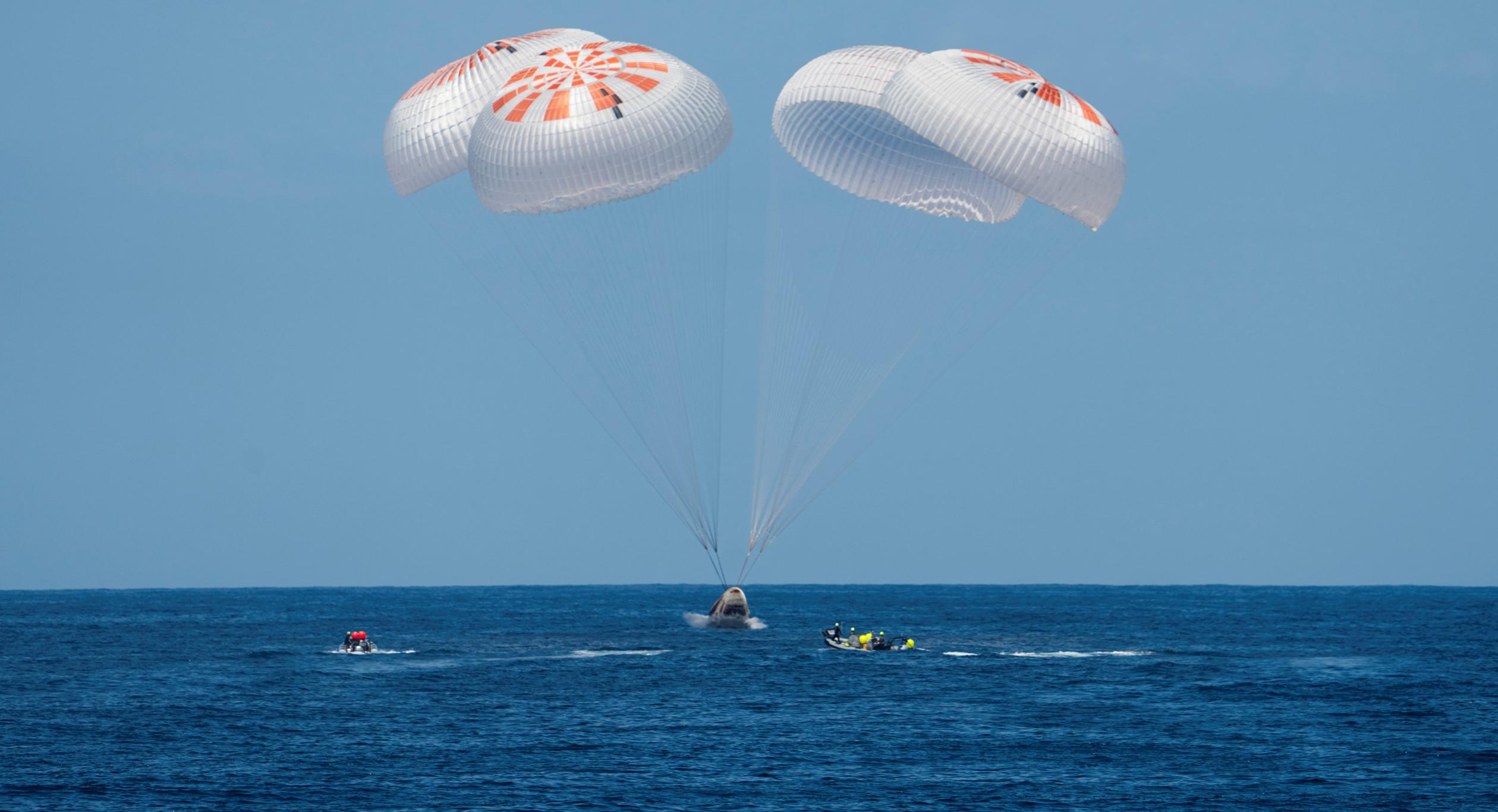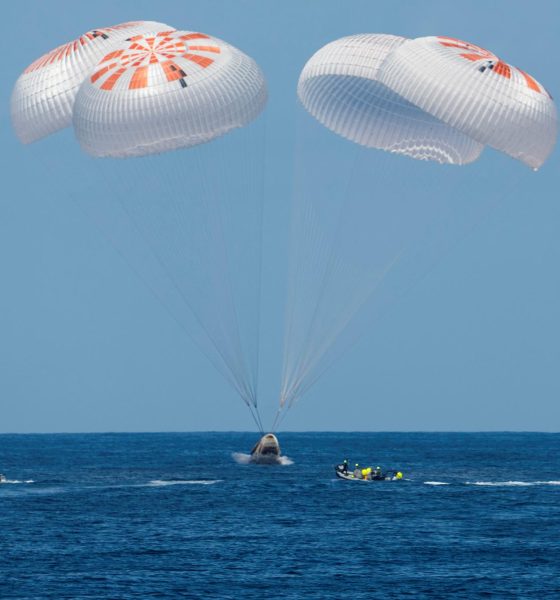

News
SpaceX Dragon returns private astronauts to Earth after an extra week in space
Update: A SpaceX Crew Dragon has finally returned Axiom Space’s first crew of four private astronauts to Earth after recovery delays ultimately gave the passengers and extra six days in space, boosting their total trip duration from 10-12 days to 17 days.
In the process, capsule C206 (Endeavour) became the first Crew Dragon to successfully transport astronauts to the International Space Station and back to Earth three times. SpaceX and NASA have already certified each Crew Dragon capsule for five flights – a number that will likely need to expanded within just a year or two. SpaceX is currently scheduled to launch Crew-4 no earlier than (NET) April 27th, Axiom-2 NET Q3 2022, Crew-5 NET October 2022, and Polaris Dawn NET late 2022.
Following extensive weather delays, a SpaceX Crew Dragon spacecraft has undocked from the International Space Station (ISS) after carrying the first all-private astronaut mission to the orbital outpost.
That private mission – known as Axiom-1 – was originally supposed to head to the ISS in February and, later, late March. For unspecified reasons, apparent issues with processing or Dragon/Falcon refurbishment ultimately pushed Ax-1’s launch to April 8th. Initially, the crew of four astronauts – one former NASA astronaut turned Axiom pilot and three wealthy paying customers – were scheduled to spend around ten days in space and eight days aboard the ISS. At some point before liftoff, that was updated to 12 days in space and 10 days aboard the station.
Shortly before liftoff, NASA’s official schedule had Axiom-1’s undocking and space station departure penciled in for April 19th. On April 19th, NASA, SpaceX, and Axiom decided to waive off the first departure attempt due to weather issues that were apparently impacting all seven of Crew Dragon’s nominal recovery zones – four in the Gulf of Mexico and three in the Atlantic Ocean. On April 20th, the next undocking attempt was pushed to no earlier than April 23rd. On April 23rd, the teams yet again called off the departure.
Finally, at 9:10 pm EDT on April 24th, the heavens apparently aligned and the Axiom-1 crew was able to board Crew Dragon, undock from the ISS, and begin their ~15-hour trip back to Earth. Until splashdown (NET 1pm EDT, April 25th), however, SpaceX and NASA will still be unable to settle with any confidence on a firm launch date for their Crew-4 NASA and ESA astronaut transport mission. Originally scheduled for April 15th, Axiom-1’s delays have pushed the Crew-4 launch to no earlier than (NET) 3:52 am EDT (07:52 UTC) on April 27th – nearly two weeks behind schedule.
Thankfully, that should be no problem for the ISS or Crew-3. Crew Dragon is currently certified to spend up to 210 days in orbit, and NASA had already planned for Crew-3 to return before even the usual six-month stint aboard the space station, so Crew-4 could have slipped well into early June 2022 without much of a problem. Nonetheless, NASA still plans to inspect the Axiom-1 Crew Dragon and analyze all data gathered from the mission to ensure nothing was amiss before giving SpaceX the green light to launch Crew-4.
Due to the current proximity of Axiom-1’s splashdown and Crew-4’s launch, even a minor delay or issue during the post-flight review would likely push Crew-4 to April 28th. With any luck, though, Axiom-1’s recovery and data review will be close to perfect and allow Crew-4 to finally get off the ground on the 27th.
Simultaneously, SpaceX is preparing to launch another batch of Starlink satellites as early as April 29th. If both missions avoid delays, Starlink 4-16 will be the company’s sixth launch in April and 17th launch this year.

News
Tesla FSD fleet is nearing 7 billion total miles, including 2.5 billion city miles
As can be seen on Tesla’s official FSD webpage, vehicles equipped with the system have now navigated over 6.99 billion miles.

Tesla’s Full Self-Driving (Supervised) fleet is closing in on almost 7 billion total miles driven, as per data posted by the company on its official FSD webpage.
These figures hint at the massive scale of data fueling Tesla’s rapid FSD improvements, which have been quite notable as of late.
FSD mileage milestones
As can be seen on Tesla’s official FSD webpage, vehicles equipped with the system have now navigated over 6.99 billion miles. Tesla owner and avid FSD tester Whole Mars Catalog also shared a screenshot indicating that from the nearly 7 billion miles traveled by the FSD fleet, more than 2.5 billion miles were driven inside cities.
City miles are particularly valuable for complex urban scenarios like unprotected turns, pedestrian interactions, and traffic lights. This is also the difference-maker for FSD, as only complex solutions, such as Waymo’s self-driving taxis, operate similarly on inner-city streets. And even then, incidents such as the San Francisco blackouts have proven challenging for sensor-rich vehicles like Waymos.
Tesla’s data edge
Tesla has a number of advantages in the autonomous vehicle sector, one of which is the size of its fleet and the number of vehicles training FSD on real-world roads. Tesla’s nearly 7 billion FSD miles then allow the company to roll out updates that make its vehicles behave like they are being driven by experienced drivers, even if they are operating on their own.
So notable are Tesla’s improvements to FSD that NVIDIA Director of Robotics Jim Fan, after experiencing FSD v14, noted that the system is the first AI that passes what he described as a “Physical Turing Test.”
“Despite knowing exactly how robot learning works, I still find it magical watching the steering wheel turn by itself. First it feels surreal, next it becomes routine. Then, like the smartphone, taking it away actively hurts. This is how humanity gets rewired and glued to god-like technologies,” Fan wrote in a post on X.
News
Tesla starts showing how FSD will change lives in Europe
Local officials tested the system on narrow country roads and were impressed by FSD’s smooth, human-like driving, with some calling the service a game-changer for everyday life in areas that are far from urban centers.

Tesla has launched Europe’s first public shuttle service using Full Self-Driving (Supervised) in the rural Eifelkreis Bitburg-Prüm region of Germany, demonstrating how the technology can restore independence and mobility for people who struggle with limited transport options.
Local officials tested the system on narrow country roads and were impressed by FSD’s smooth, human-like driving, with some calling the service a game-changer for everyday life in areas that are far from urban centers.
Officials see real impact on rural residents
Arzfeld Mayor Johannes Kuhl and District Administrator Andreas Kruppert personally tested the Tesla shuttle service. This allowed them to see just how well FSD navigated winding lanes and rural roads confidently. Kruppert said, “Autonomous driving sounds like science fiction to many, but we simply see here that it works totally well in rural regions too.” Kuhl, for his part, also noted that FSD “feels like a very experienced driver.”
The pilot complements the area’s “Citizen Bus” program, which provides on-demand rides for elderly residents who can no longer drive themselves. Tesla Europe shared a video of a demonstration of the service, highlighting how FSD gives people their freedom back, even in places where public transport is not as prevalent.
What the Ministry for Economic Affairs and Transport says
Rhineland-Palatinate’s Minister Daniela Schmitt supported the project, praising the collaboration that made this “first of its kind in Europe” possible. As per the ministry, the rural rollout for the service shows FSD’s potential beyond major cities, and it delivers tangible benefits like grocery runs, doctor visits, and social connections for isolated residents.
“Reliable and flexible mobility is especially vital in rural areas. With the launch of a shuttle service using self-driving vehicles (FSD supervised) by Tesla in the Eifelkreis Bitburg-Prüm, an innovative pilot project is now getting underway that complements local community bus services. It is the first project of its kind in Europe.
“The result is a real gain for rural mobility: greater accessibility, more flexibility and tangible benefits for everyday life. A strong signal for innovation, cooperation and future-oriented mobility beyond urban centers,” the ministry wrote in a LinkedIn post.
News
Tesla China quietly posts Robotaxi-related job listing
Tesla China is currently seeking a Low Voltage Electrical Engineer to work on circuit board design for the company’s autonomous vehicles.

Tesla has posted a new job listing in Shanghai explicitly tied to its Robotaxi program, fueling speculation that the company is preparing to launch its dedicated autonomous ride-hailing service in China.
As noted in the listing, Tesla China is currently seeking a Low Voltage Electrical Engineer to work on circuit board design for the company’s autonomous vehicles.
Robotaxi-specific role
The listing, which was shared on social media platform X by industry watcher @tslaming, suggested that Tesla China is looking to fill the role urgently. The job listing itself specifically mentions that the person hired for the role will be working on the Low Voltage Hardware team, which would design the circuit boards that would serve as the nervous system of the Robotaxi.
Key tasks for the role, as indicated in the job listing, include collaboration with PCB layout, firmware, mechanical, program management, and validation teams, among other responsibilities. The role is based in Shanghai.
China Robotaxi launch
China represents a massive potential market for robotaxis, with its dense urban centers and supportive policies in select cities. Tesla has limited permission to roll out FSD in the country, though despite this, its vehicles have been hailed as among the best in the market when it comes to autonomous features. So far, at least, it appears that China supports Tesla’s FSD and Robotaxi rollout.
This was hinted at in November, when Tesla brought the Cybercab to the 8th China International Import Expo (CIIE) in Shanghai, marking the first time that the autonomous two-seater was brought to the Asia-Pacific region. The vehicle, despite not having a release date in China, received a significant amount of interest among the event’s attendees.








